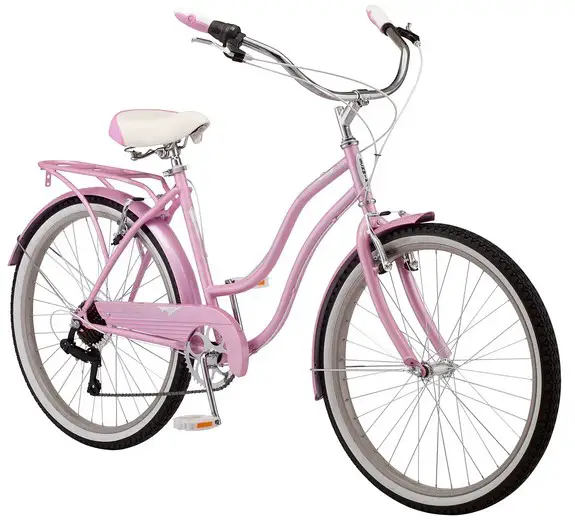Plenty of factors like wheel size play a critical role when shopping for a bicycle, whether replacing your old one or shopping for your first. Wheel sizes vary based on the bike‘s purpose, and today, we’ll examine the 24 vs 26 bike to help you choose the one that fits you.
24-inch bikes are typically made for growing children ages 8 to 12 and best fitted for 4’1” to 4’9” (135-145 cm) riders. On the other hand, 26-inch bikes are designed for 5’0” to 5’5” cyclists and are ideal for 11-year-olds and above. Moreover, taller riders can try out a 26 bike to see if it fits.
It is essential to ensure you pick a bike that corresponds with your height because the wrong bike size will affect your performance and health. Riding a smaller bike will leave you feeling uncomfortable and sore after a long ride.

Is There A Big Difference Between A 24 And 26 Inch Bike? (24 Vs 26 Bike Explained!)
The wheelbase and tire clearance differentiate a 24-inch bike from a 26-inch bike, and the difference is noticeable. The difference is significant enough because these bikes are suited for riders of varying heights.
A 26-inch bike has a longer wheelbase and more ample tire clearance compared to 14-inch bikes. This is why 26-inch bicycles fit taller riders better and are easier to ride.
In addition, 26-inch wheels may provide more traction when riding on slick roads or loose surfaces. Their bigger size lets them keep ground contact even on rugged roads.
Can You Put 26-Inch Wheels On a 24-Inch Bike?
It’s better to ride on bigger wheels, especially on rough terrains, because they offer more traction and stability. However, converting a 24-inch wheel bike to a 26-inch wheel bicycle is easier said than done.
Most 24-inch bicycles are too narrow and small to accommodate 26-inch wheels unless your bike is explicitly designed to ride on more than one wheel size.
Can You Fit A 26-Inch Bike Wheels On A 24-Inch Bike?
You’ll need to determine if a 24-inch bike can use 26-inch wheels by checking the manufacturer’s website. Alternatively, measure the 26-inch wheel’s radius and the tire’s width and compare them to the clearance given by your 24-inch bike’s fork and frame.
Before measuring the tire width and the wheel radius, make sure you pump the tires to your preferred air pressure.
How To Determine If A 26-Inch Wheels Will Fit Your Bike
1. Measure The Frame And Fork Clearance.
Here’s how to find out the clearance on your bike’s fork and frame.
Frame– determine the distance from the dropouts to the chainstay bridge, including the narrowest gaps found between the chainstays. If your bike doesn’t have a chainstay, measure the length from the dropouts to the seat tube.
Fork– Measure the length from the bike’s dropouts to the crown’s lower wall and the narrowest gap found between the legs of the fork.
2. Divide a minimum of 5-8mm from both measurements to make sure the wheels will not rub, then compare what you get with the wheel width and radius.
3. If the wheel size exceeds your findings, you can install the 26-inch wheels you got. In that case, find narrower tires, then try again. You could also change the bike frame or keep cycling with the 24-inch wheels.

What Problems Stem From Fitting 26-Inch Wheels On A 24-Inch Bike?
Your bike frame and fork may be large enough for 26-inch wheels to fit in, but the combination creates the problems listed below:
a) Raised Bottom Bracket
26-inch wheels will raise a 24-inch bike’s bottom bracket, potentially causing instability problems. An MTB frame will be more susceptible to this issue because the bottom brackets on mountain bikes are bigger to offer extra clearance.
b) Most Rim Brakes Will Not Work
The brake mounts on 24-inch forks and frames are lower compared to 26-inch models since there are smaller rims on 24-inch wheels. The brake bosses’ position depends on the bike’s wheel size because the brakes must grab the rim.
The rim will end up far over the brake bosses if you install 26-inch wheels on a 24-inch frame or fork, rendering using original brakes impossible.
You can solve this problem by using V-brake mount raisers, V-brake clamp adapters, removing and re-wilding the original brake mounts, or switching to caliper brakes.
c) Unpleasant Geometry
Putting larger wheels on your bike without changing the frame will alter its geometry, with the wheels likely looking disproportional to the frame. Moreover, you may find the geometry compressing/limiting.
d) Severe Toe Overlap
24-inch bikes are typically compact with shorter frames and cranks. Therefore, increasing the wheel size raises the risk of your toes hitting the bike tires significantly.
e) Lack Of Fender Clearance
Installing 26-inch wheels on a 24-inch bike will take away the space you’d use to put in full fenders.

What Bike Size Is Right For You? (24 Vs 26 Bike)
The wheel size is not only dictated by your height but also where you plan to ride your bicycle. Therefore, let’s look at which bike wheel size between 24-inch vs 26-inch bike wheels is ideal for mountain bikes, cruiser bikes, BMX bikes, and trials bikes.
1. 24 Vs 26 Mountain Bike
Wheel size matters in mountain biking because it affects your comfort, riding position and style, resistance levels, and the ability to overcome obstacles. When it comes to height and age, the 24-inch and 26-inch mountain bikes are ideal for different riders.
24-inch mountain bikes are designed for 8 to 12 year olds or 50-58-inch riders. A worthy 24-inch mountain bike to consider is the Huffy Hardtail Mountain Bike (View on Amazon) with a padded saddle, front suspension, 21 speeds, and a 14-inch frame.
On the other hand, 26-inch mountain bikes are suitable for 5’4” to 5’7” (160-170cm ) tall adults.
2. 24 Vs 26 Trials Bike
Stock bikes have 26-inch wheels, which are bigger and usually a bit heavier than the 20-inch wheels on Mod bikes. The 26-inch wheels roll over obstacles better and are more stable.
On the other hand, the 24-inch wheels fall between the 20-inch and 26-inch wheels but lean more toward the bigger 26”. Their popularity is on the rise, and many trials bikes riders prefer them because they offer the best of the other two options.
For instance, they are large enough to easily go over obstacles, more playful, and shorter than 26-inch wheels.
Taller riders are better suited for 26-inch Trials bikes, while medium-height cyclists fit the 24-inch models.
3. 24 Vs 26 BMX Bike
Most BMX bikes are designed with 20-inch wheels, but you can find some with 24-inch and 26-inch wheels. While adults can ride 20-inch BMX bikes, you can go a bigger size for a comfortable ride.
24-inch and 26-inch BMX bikes are more comfortable and embody a commuter style while maintaining the BMX design. They allow you to jump, perform tricks, and cruise around.
24-inch BMX bikes are ideal for riders taller than 170 cm. On the other hand, 26-inch-inch BMX bikes are designed for riders looking for a standard mountain bike with a BMX bike’s durability and simplicity.
4. 24 Vs 26 Cruiser Bike
Cruiser bikes are all about comfort, so you should experience precisely that while riding yours. You must have a cruiser bicycle that fits you for that to happen.
In that case, 4’0” to 5’0” riders should ride a 24-inch beach cruiser, while 5’0” to 6’3” cyclists will be comfortable on 26-inch models.
An excellent example of a 26-inch cruiser is Schwinn Perla Cruiser (View on Amazon) with 7 speeds, a vintage style, a quilted seat, and sweptback handlebars. It fits 64-74-inch riders.

Can A Woman Ride A 24 Inch Bike? (24 Vs 26 Bike)
A woman within the height range of 4’1” to 4’9” can ride a 24-inch bike because the frame’s height can accommodate their leg length and allow them to pedal efficiently.
Small women will find controlling bigger bikes like a 26-inch bike challenging.
You can ride a 24-inch bike if you can pedal the bike without locking your knee and reach the brakes and handlebars. However, you’ll be better off test riding it first to ensure you feel comfortable in it.
FAQs
1. Is 24 Inch Bike Good For What Height?
24-inch bikes are built to fit 135-145 cm (4’1” to 4’9”) riders. These bikes feature smaller frames, narrower handlebars and seats, and pedal positions suited for kids.
In addition, adults who are 4’1” to 4’9” tall can also ride 24-inch bikes comfortably. However, they should test ride them before buying to ensure the brakes, pedals, handlebar, seat, and height are convenient and well-coordinated.
2. Is 26-Inch Bike Good For What Height?
26-inch bikes are typically adult-sized, thus suited for adult men and women. They are ideal for 5’0” to 5’5”, so riders taller than that should consider 27.5-inch or 29-inch models.
3. What Age Is A 24 Inch Bike For?
24-inch bikes are built for 8 to 12 year olds.
4. Is A 26 Mountain Bike For Adults?
Mountain bikes usually come with 26-inch wheels, a size well-suited for adults who are 5’4” to 5’7” (160-170 cm) tall. It also suits riders with 25-30 inch (63-76 cm) long leg inseam.
5. Difference Between A 24 Inch Bike And A 26 Inch Bike?
A 24-inch bike has a shorter wheelbase and more clearance on the tires; that’s why they are perfect for shorter riders. 26-inch wheels also provide better traction because of their increased size.
6. Is A 26 Bike For Adults Or Kids?
Most 26-inch bicycles are sized for adults; hence, big for kids. Therefore, adult riders are better positioned to ride 26” bike models because they can comfortably reach the handlebar and pedals.
Conclusion
In a 24 vs 26 bike comparison, the choice comes down to your height, as that will determine if the bike will fit you and let you ride in comfort.
Bike wheels are available in various sizes, offering an ideal saddle-to-handlebar ratio proportional to riders of different heights.
24-inch bikes are more accessible to shorter riders while 24-inch suit taller ones.
Also Read:
